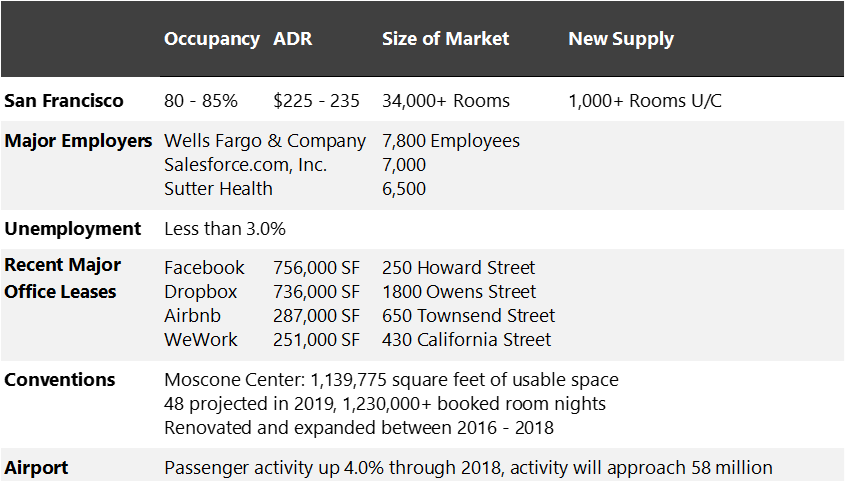By John Berean
San Francisco continues to rank among the top domestic lodging markets, attributed to the strength of the tech industry, strong year-round tourism, and limited supply growth. With the Moscone Convention Center also recently debuting a $550-million renovation and expansion, the San Francisco hotel market is expected to achieve record RevPAR levels in 2019. We have outlined several key trends that are anticipated to influence San Francisco’s lodging market in the near term.
San Francisco's Key Economic Indicators
Construction on the renovation and expansion of San Francisco’s Moscone Center began in November 2014. More than four years and $550 million later, the convention center officially debuted its new look in the first week of 2019. In anticipation of the expansion, many hotels in the city also underwent renovations during the last several years, totaling an estimated cost of more than $275 million. Some notable upgrades include the $60-million renovation of the Hotel Nikko, the $16-million renovation and rebranding of the Hotel Spero (formerly known as the Serrano Hotel), and the $45-million renovation of the Westin St. Francis. Other planned or currently ongoing renovations include the Marriott Marquis, W Hotel, Clift Royal Sonesta Hotel, and the Hotel Rex.
During Moscone Center’s renovation, the number of group bookings dropped from just over 1,020,000 in 2014 to a low of nearly 610,000 in 2017; however, SF Travel is expecting a record convention year with more than 1,210,000 room nights booked for this calendar year.
While the numbers look promising, some of the largest conventions are reportedly at risk of relocating their events to other cities, citing issues such as unsafe streets and the homeless population. In June 2018, Ms. London Breed was elected the new mayor of San Francisco; her campaign focused heavily on solving the city’s housing and homeless crisis and their attendant issues. Prop. C, passed by roughly 60% of the city’s voters in November 2018, is expected to raise between $250 and $300 million per year, with the proceeds dedicated toward homeless programs.
The high room rates that hotels in San Francisco command (the second highest for a major city in the United States) is also becoming an issue for conventions, event planners, and price-sensitive leisure travelers. Moreover, the entrance of new supply in the near term is not likely to relieve rate growth. After several years of limited supply growth, the city is preparing for an influx of new hotel development. Aside from the recent openings of the Hotel Via and Proper Hotel in 2017, three more hotels are expected to open during the first quarter of 2019, including the Virgin Hotel, Hyatt Place, and YOTEL. Other brands that have announced intentions to enter the market or are currently in development include Waldorf Astoria Hotels & Resorts, Langham Hotels & Resorts, CitizenM, AC Hotel by Marriott, LINE Hotels, and Soho House. While San Francisco still appears prime for development, with more than 7,500 hotel rooms in the pipeline (representing roughly 20% of existing supply), skyrocketing costs of construction and slow city permitting processes have hampered any significant increases in the total number of available room nights.
The high cost of living in the San Francisco Bay Area has also begun to impact hotel operations in the region. Many hotel employees that work in the city are commuting from as far away as Antioch and Tracy due to a lack of affordable housing. Increases in California’s minimum wage, from $10.50 in 2017 to $15 by 2022, will also likely affect hotel profitability. Furthermore, competitive wages in other service-sector jobs have created a labor shortage in the local hotel industry.
Despite these challenges, the outlook for San Francisco’s lodging market remains positive. The San Francisco International Airport achieved a new record for passenger traffic in 2017, setting a high for the sixth year in a row. Despite the ongoing $2.4-billion construction project at Terminal 1, year-to-date statistics through October 2018 suggest another record year. The Golden State Warriors, fresh off their third finals win in four years, will relocate to the Chase Center in San Francisco’s Mission Bay neighborhood for the 2019/20 NBA season. The completion of major construction projects in Downtown San Francisco, including the Salesforce Tower and the Transbay Transit Center, should also support continued demand growth. Furthermore, the city set a new record for office space leased, with more than 11.9 million square feet in new deals and lease renewals negotiated in 2018.


